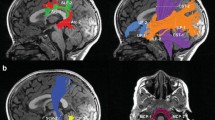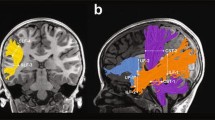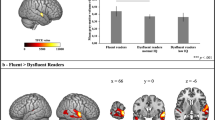Abstract
Reading in children has been associated with microstructural properties of the cerebellar peduncles, the white matter pathways connecting the cerebellum to the cerebrum. In this study, we used two independent neuroimaging modalities to assess which features of the cerebellar peduncles would be associated with reading. Twenty-three 8-year-old children were evaluated on word reading efficiency and imaged using diffusion MRI (dMRI) and quantitative T1 relaxometry (qT1). We segmented the superior (SCP), middle, and inferior cerebellar peduncles and extracted two metrics: fractional anisotropy (FA) from dMRI and R1 from qT1. Tract-FA was significantly correlated with tract-R1 in left and right SCPs (left: rP(21) = .63, right: rP(21) = .76, p ≤ .001) suggesting that FA of these peduncles, at least in part, indexed myelin content. Tract-FA and tract R1 were not correlated in the other cerebellar peduncles. Reading efficiency negatively correlated with tract-FA of the left (rP(21) = − .43, p = .040) and right SCP (rP(21) = − .37, p = .079). Reading efficiency did not correlate with tract-R1 in the SCPs. The negative association of reading efficiency with tract-FA and the lack of association of reading efficiency with tract-R1 implicate properties other than myelin content as relevant to the information flow between the cerebellum and the cerebrum for individual differences in reading skills in children.

Similar content being viewed by others
Data Availability
The data from this study will be made available on request.
References
Manto M, Bower JM, Conforto AB, Delgado-García JM, da Guarda SNF, Gerwig M, et al. Consensus paper: roles of the cerebellum in motor control--the diversity of ideas on cerebellar involvement in movement. Cerebellum (London, England). 2012;11(2):457–87. https://doi.org/10.1007/s12311-011-0331-9.
Morton SM, Bastian AJ. Cerebellar control of balance and locomotion. Neuroscientist. 2004;10(3):247–59. https://doi.org/10.1177/1073858404263517.
Alvarez TA, Fiez JA. Current perspectives on the cerebellum and reading development. Neurosci Biobehav Rev. 2018;92:55–66. https://doi.org/10.1016/J.NEUBIOREV.2018.05.006.
Fiez JA, Petersen SE. Neuroimaging studies of word reading. Proc Natl Acad Sci. 1998;95(3):914–21. https://doi.org/10.1073/pnas.95.3.914.
Fulbright RK, Jenner AR, Mencl WE, Pugh KR, Shaywitz BA, Shaywitz SE, et al. The cerebellum’s role in reading: a functional MR imaging study. AJNR Am J Neuroradiol. 1999;20(10):1925–30 Retrieved from http://www.ncbi.nlm.nih.gov/pubmed/10588120. Accessed 06 July 2020.
Stoodley CJ, Stein JF. Cerebellar function in developmental dyslexia. Cerebellum. 2013;12(2):267–76. https://doi.org/10.1007/s12311-012-0407-1.
Booth JR, Wood L, Lu D, Houk JC, Bitan T. The role of the basal ganglia and cerebellum in language processing. Brain Res. 2007;1133:136–44. https://doi.org/10.1016/j.brainres.2006.11.074.
Stoodley CJ. The cerebellum and cognition: evidence from functional imaging studies. Cerebellum. 2012;11(2):352–65. https://doi.org/10.1007/s12311-011-0260-7.
Turkeltaub PE, Eden GF, Jones KM, Zeffiro TA. Meta-analysis of the functional neuroanatomy of single-word reading: method and validation. NeuroImage. 2002;16(3 Pt 1):765–80 Retrieved from http://www.ncbi.nlm.nih.gov/pubmed/12169260. Accessed 06 July 2020.
Borchers LR, Bruckert L, Dodson CK, Travis KE, Marchman VA, Ben-Shachar M, et al. Microstructural properties of white matter pathways in relation to subsequent reading abilities in children: a longitudinal analysis. Brain Struct Funct. 2018;224:1–15. https://doi.org/10.1007/s00429-018-1813-z.
Travis KE, Leitner Y, Feldman HM, Ben-Shachar M. Cerebellar white matter pathways are associated with reading skills in children and adolescents. Hum Brain Mapp. 2015b;36(4):1536–53. https://doi.org/10.1002/hbm.22721.
Mezer A, Yeatman JD, Stikov N, Kay KN, Cho N-J, Dougherty RF, et al. Quantifying the local tissue volume and composition in individual brains with magnetic resonance imaging. Nat Med. 2013;19(12):1667–72. https://doi.org/10.1038/nm.3390.
Stüber C, Morawski M, Schäfer A, Labadie C, Wähnert M, Leuze C, et al. Myelin and iron concentration in the human brain: a quantitative study of MRI contrast. NeuroImage. 2014;93:95–106. https://doi.org/10.1016/j.neuroimage.2014.02.026.
Travis KE, Golden NH, Feldman HM, Solomon M, Nguyen J, Mezer A, et al. Abnormal white matter properties in adolescent girls with anorexia nervosa. NeuroImage: Clinical. 2015a;9:648–59. https://doi.org/10.1016/J.NICL.2015.10.008.
Travis KE, Castro MRH, Berman S, Dodson CK, Mezer AA, Ben-Shachar M, et al. More than myelin: probing white matter differences in prematurity with quantitative T1 and diffusion MRI. NeuroImage: Clinical. 2019;22:101756. https://doi.org/10.1016/j.nicl.2019.101756.
Travis KE, Adams JN, Kovachy VN, Ben-Shachar M, Feldman HM. White matter properties differ in 6-year old readers and pre-readers. Brain Struct Funct. 2016;222:1–19. https://doi.org/10.1007/s00429-016-1302-1.
Wechsler D, Hsiao-pin C. WASI-II : Wechsler abbreviated scale of intelligence. Bloomington: Pearson; 2011.
Semel EM, Wiig EH, Secord W. CELF 4 : clinical evaluation of language fundamentals 4 screening test. San Antonio: Pearson, PsyhCorp; 2004.
Hollingshead AB. Four factor index of social status [1975]. 1975. Retrieved from https://ubir.buffalo.edu/xmlui/handle/10477/1879. Accessed 06 July 2020.
Torgesen JK, Wagner R, Rashotte C. Test of word reading efficiency–second edition (TOWRE-2). Circle Pines, MN: AGS. 2012.
Bruckert L, Shpanskaya K, McKenna ES, Borchers LR, Yablonski M, Blecher T, et al. Age-dependent white matter characteristics of the cerebellar peduncles from infancy through adolescence. Cerebellum. 2019;18:1–16. https://doi.org/10.1007/s12311-018-1003-9.
Dodson CK, Travis KE, Borchers LR, Marchman VA, Ben-Shachar M, Feldman HM. White matter properties associated with pre-reading skills in 6-year-old children born preterm and at term. Dev Med Child Neurol. 2018;60(7):695–702. https://doi.org/10.1111/dmcn.13783.
Mezer A, Rokem A, Berman S, Hastie T, Wandell BA. Evaluating quantitative proton-density-mapping methods. Hum Brain Mapp. 2016;37(10):3623–35. https://doi.org/10.1002/hbm.23264.
Rohde GK, Barnett AS, Basser PJ, Marenco S, Pierpaoli C. Comprehensive approach for correction of motion and distortion in diffusion-weighted MRI. Magn Reson Med. 2004;51(1):103–14. https://doi.org/10.1002/mrm.10677.
Chang L-C, Jones DK, Pierpaoli C. RESTORE: robust estimation of tensors by outlier rejection. Magn Reson Med. 2005;53(5):1088–95. https://doi.org/10.1002/mrm.20426.
Barral JK, Gudmundson E, Stikov N, Etezadi-Amoli M, Stoica P, Nishimura DG. A robust methodology for in vivo T1 mapping. Magn Reson Med. 2010;64(4):1057–67. https://doi.org/10.1002/mrm.22497.
Chang L-C, Koay CG, Basser PJ, Pierpaoli C. Linear least-squares method for unbiased estimation of T 1 from SPGR signals. Magn Reson Med. 2008;60(2):496–501. https://doi.org/10.1002/mrm.21669.
Avants B, Tustison N, Song G. Advanced normalization tools (ANTS). Insight J. 2009;2:1–35 Retrieved from https://scicomp.ethz.ch/public/manual/ants/2.x/ants2.pdf. Accessed 06 July 2020.
Berman S, West KL, Does MD, Yeatman JD, Mezer AA. Evaluating g-ratio weighted changes in the corpus callosum as a function of age and sex. NeuroImage. 2018;182:304–13. https://doi.org/10.1016/j.neuroimage.2017.06.076.
Tournier J-D, Calamante F, Connelly A. MRtrix: diffusion tractography in crossing fiber regions. Int J Imaging Syst Technol. 2012;22(1):53–66. https://doi.org/10.1002/ima.22005.
Yeatman JD, Dougherty RF, Myall NJ, Wandell BA, Feldman HM. Tract profiles of white matter properties: automating fiber-tract quantification. PLoS One. 2012;7(11):e49790. https://doi.org/10.1371/journal.pone.0049790.
Jansen A, Flöel A, Van Randenborgh J, Konrad C, Rotte M, Förster A-F, et al. Crossed cerebro-cerebellar language dominance. Hum Brain Mapp. 2005;24(3):165–72. https://doi.org/10.1002/hbm.20077.
Naidich TP, Duvernoy HM, Delman BN, Sorensen AG, Kollias SS, Haacke EM. Duvernoy's atlas of the human brain stem and cerebellum: highfield MRI, surface anatomy, internal structure, vascularization and 3 D sectional anatomy. Springer Science & Business Media; 2009.
Dougherty RF, Ben-Shachar M, Deutsch GK, Hernandez A, Fox GR, Wandell BA. Temporal-callosal pathway diffusivity predicts phonological skills in children. Proc Natl Acad Sci. 2007;104(20):8556–61.
Odegard TN, Farris EA, Ring J, McColl R, Black J. Brain connectivity in non-reading impaired children and children diagnosed with developmental dyslexia. Neuropsychologia. 2009;47(8–9):1972–7. https://doi.org/10.1016/J.NEUROPSYCHOLOGIA.2009.03.009.
Yeatman JD, Dougherty RF, Rykhlevskaia E, Sherbondy AJ, Deutsch GK, Wandell BA, et al. Anatomical properties of the arcuate fasciculus predict phonological and reading skills in children. J Cogn Neurosci. 2011;23(11):3304–17. https://doi.org/10.1162/jocn_a_00061.
Assaf Y, Blumenfeld-Katzir T, Yovel Y, Basser PJ. Axcaliber: a method for measuring axon diameter distribution from diffusion MRI. Magn Reson Med. 2008;59(6):1347–54. https://doi.org/10.1002/mrm.21577.
Zhang H, Schneider T, Wheeler-Kingshott CA, Alexander DC. NODDI: practical in vivo neurite orientation dispersion and density imaging of the human brain. NeuroImage. 2012;61(4):1000–16. https://doi.org/10.1016/J.NEUROIMAGE.2012.03.072.
Acknowledgments
We would like to thank the children and families who participated in this study. We would also like to thank Ms. Vanessa N. Kovachy for initial recruitment and data collection, and Ms. Cory K. Dodson and Ms. Lauren R. Borchers for completing recruitment and their help with diffusion data pre-processing.
Funding
This study was funded by the Eunice Kennedy Shriver National Institute of Child Health and Human Development (RO1 HD069162 to Feldman, PI) and the Stanford Transdisciplinary Initiatives Program, Maternal & Child Health Research Institute (1186741–-100-DHDHY).
Author information
Authors and Affiliations
Corresponding author
Ethics declarations
The Stanford University Institutional Review Board approved the research protocol. For all children included in the study, informed consent was obtained from a parent or guardian at the first visit; children over the age of 7 years provided assent; and children were compensated for the behavioral testing session and the MRI scan.
Conflict of Interest
The authors declare that they have no conflict of interest.
Additional information
Publisher’s Note
Springer Nature remains neutral with regard to jurisdictional claims in published maps and institutional affiliations.
Electronic Supplementary Material
ESM 1
(DOCX 6859 kb)
Rights and permissions
About this article
Cite this article
Bruckert, L., Travis, K.E., Mezer, A.A. et al. Associations of Reading Efficiency with White Matter Properties of the Cerebellar Peduncles in Children. Cerebellum 19, 771–777 (2020). https://doi.org/10.1007/s12311-020-01162-2
Published:
Issue Date:
DOI: https://doi.org/10.1007/s12311-020-01162-2




